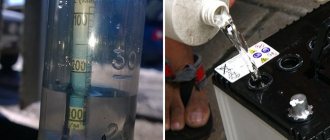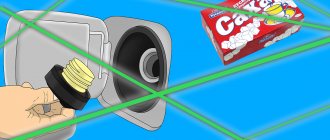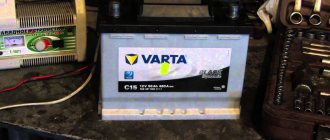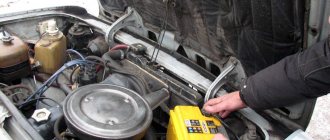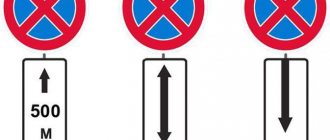The battery can operate without maintenance for about five years. However, sooner or later breakdowns happen. The car won’t start, and the driver remembers his grandfather’s old stories about how it is necessary to remove the battery from the car and take it home to warm it up. The simple procedure of removing the terminals from the battery does not frighten motorists, but in vain. After all, if the battery is incorrectly removed or installed, the vehicle's electronics can suffer great damage. And most often, damage to equipment is caused by trivial errors in determining polarity.
How easy is it to mix up battery terminal poles?
Most manufacturers, having foreseen the possibility of such a scenario, took a number of measures to prevent a possible oversight.
The first thing that is not so much striking, but rather felt to the touch, is the thickness of the battery terminals themselves.
The positive one is usually specially made thinner so that even in poor lighting conditions it is possible to correctly connect the contacts. In addition, this greatly simplifies the process for people with vision problems.
The second (which is also difficult not to notice) are two “plus” and “minus” icons, respectively. With a little care, you can successfully use this fairly accurate hint.
If the indicators listed above are unavailable for some reason, such a useful device as a tester comes to the rescue. With its help, you can determine with absolute accuracy the pole for attaching the terminal.
Moreover, even a discharged battery will most likely allow this operation, which does not require capacity, to be performed.
The standard among manufacturers is to make the positive terminal and the contact itself on the battery red (any remaining one, accordingly, will be negative).
Unsuccessful "lighting"
Negative consequences can arise from improper removal and installation of terminals and wires when “lighting” another car.
Is it possible to remove glitches in a car by rebooting the main computer? More details
It is especially dangerous when drivers try to start a stalled car using a battery from another vehicle, without knowing how to do it correctly. Some people pull off the positive terminal from a running machine and get a strong voltage surge. A discharge arc jumps between the electrodes, causing a short circuit, causing the fuses to blow.
It’s even worse if you throw terminals from a car with a running engine onto another car and at the same time reverse the polarity.
Then the generator relay and other electronics burn out. If you do not disconnect the wires within 1-2 minutes, the wiring will begin to melt, and here it is not far from a fire. Therefore, without thoroughly knowing the procedure for dismantling the battery and the possible negative consequences when “lighting up”, it is better not to proceed with these operations.
What happens if you mix up the terminals?
Much of the damage that such a mistake can cause depends on what will be powered by the incorrectly connected battery.
If we are talking about lighting devices, then they will most likely work the same way, but, for example, the electric motor will rotate in the opposite direction, with all the ensuing consequences.
All diode lamps, as well as boards with semiconductors, fall into the danger zone - they will most likely be damaged beyond repair.
When charging the battery
It is especially easy to confuse the connection when installing the battery for charging.
Incorrect installation
You can mix up the terminals when installing the battery back into the car. To obtain a short circuit, it is not necessary to attach the terminal retainer to the electrode. It’s enough just to hit the battery stump with it. If the installation operation is carried out with the ignition turned off, then serious consequences can still be avoided. It is much worse when a motorist tries to start the car in this condition.
Question answer
What are the dangers of removing battery terminals in cold weather? When changing the polarity of the battery, the diode bridge of the generator, as well as other electronic devices, can be damaged. This applies mainly to older cars that do not have protection against incorrect battery connection.
Most modern generators have electronic relays that control charging. That's why they mostly burn out.
In the worst case scenario, the electronic engine control unit (ECU) fails. Without it, the car will be practically paralyzed. Other electronics connected to the common bus and responsible for the operation of various options also suffer.
The security system control unit, which is sensitive to polarity changes, often burns out.
Be sure to pay attention to the wiring, and not only the one that comes from the battery, but the one in the cabin. It happens that wires that were under load during connection melt. The average battery produces a starting current of 55-200 amps, which is enough to melt insulation and set fire to upholstery panels.
What to do if the battery terminals are mixed up?
The first thing to do is to de-energize the battery, that is, limit its contact with any other sources. Afterwards, carefully examine the connection points of the terminals for possible destruction.
In the event of a fire, you must use the means provided for this and do not forget that it is not advisable to use water when igniting petroleum products.
After a shutdown, it is advisable to have an experienced electrician conduct an audit of all major electrical wiring components. But if you yourself are able to assess the situation, so much the better. After looking around, carefully change the terminals and try to start the car again. If everything went well, observe the operation of lighting fixtures and electronics to make sure everything is in order.
What are the consequences if you mix up the terminals when charging the battery?
Most chargers from well-known manufacturers are equipped with a fuse, which, if the charger is connected incorrectly to the battery terminals, will protect both the charger and the car battery. That is, you have nothing to worry about: you made a mistake, saw that recharging was not happening, replaced the fuse and repeated the connection, but this time correctly.
Unfortunately, cheap Chinese products often do not have such protection. But even in this case, the consequences for the car battery will be minimal: with a 95% probability the charger will burn out. So make sure that when purchasing a charger, it has reverse polarity protection.
What to pay attention to when charging the battery
Once you have connected the charger to the battery, do not leave it unattended for a long time. Such negligence can lead to a fire hazard! To avoid such troubles, we recommend paying attention to the following nuances:
- It is necessary to ensure that the temperature does not rise above normal. This may cause the liquid to boil over.
- The electrolyte level should not remain unchanged.
- Do not allow flammable liquids or clutter in the work area.
- It is necessary to keep the devices at a distance from each other (the length of the entire wire) and not place them one above the other.
Knowing the rules on how to connect a charger for a car battery will never be superfluous, and the use of modern smart devices will reduce any risk to a minimum.
Stories of car owners.
“Recently, in a hurry at home, I got confused with the wires while charging, indeed, everything was fine with the battery, but the charger had to be replaced: there was some kind of cheap charger, there was no fuse in it, so it burned out completely, but the main thing is that the battery is fine.”
“I don’t know how you can wait 1-2 minutes when lighting a cigarette, as soon as I touched the second terminal on the donor car, it sparkled so much that the thought of completing the connection did not even arise, they quickly turned everything off and reset it, only then did they realize that there was something wrong with the polarity got it wrong."
“Fuses are always the first thing to look at, not only when everything seems fine, but also when the car won’t start. They are the first thing that flies when the terminals are confused.”
“I was always surprised how people can mess up terminals, but last week I encountered this myself - I installed the battery late in the evening, when it was already dark, and so I got it wrong. As a result, the car stopped starting, although the starter clicked. I went through all the fuses, everything is fine, checked the generator and so on, in general, it turned out that the battery simply died... although the headlights turned on, it was clear that the power had dropped significantly.”
Incorrect connection of terminals when lighting.
When lighting a cigarette, the situation worsens significantly: a vigorous, powerful source + a battery that they want to “smoke” (not quite dead yet) + often a running engine = a hellish mixture, practically fireworks under the hoods and an inevitable fire if the wires are not disconnected within 1-2 minutes (see how to light a cigarette correctly here).
But the wires get confused not only in the car, but also at home, when charging, what happens then.
By and large, nothing happens in such cases. The battery always remains intact; the only thing that is at risk is the charger. Moreover, as a rule, he always remains alive, only his fuse burns out, which is easily changed.
Consequences of incorrect battery connection
Let’s immediately dispel the myth that a battery connected “backwards” starts the engine in the opposite direction. Let's start with the starter: if the stator has a winding and not permanent magnets, then when the polarity is reversed, the direction of the current will change simultaneously in both the stator and the rotor, the starter will begin to rotate in the same direction as before. Think about the commutator motors of electric drills, grinders and other tools - they operate on alternating current, the direction of which is constantly changing.
A starter with permanent magnets on the stator will indeed begin to rotate in a different direction, but will not be able to crank the engine. Bendix will not allow force to be transferred in the “wrong” direction, that’s what it is designed for.
Even if you managed to spin the engine in the opposite direction, the four-stroke engine begins to take air from the exhaust manifold and throw exhaust gases into the intake manifold. So neither a carburetor nor an injection engine can be started this way, unless a diesel engine with a mechanical injection pump starts.
If the driver reverses the polarity of the battery during installation, then one of the most serious consequences will be that the generator will definitely suffer. Look at the diagram of its diode bridge (using the example of the simplest “Zhiguli” circuit):
A semiconductor diode is an element with one-way conductivity; it is not for nothing that its symbolic image looks like an arrow. It conducts current in the direction of this “arrow”, but not in the opposite direction. When the battery is connected correctly, then while the generator is not working (the voltage on its windings is less than the battery voltage), the diodes are locked - for the battery, the generator is a load that consumes several milliamps due to the presence of a small reverse current in the diodes.
Generator failure
Most often, the car generator is sufficiently protected from breakdowns using a diode bridge. Of course, if it is available. When it is missing, confusion with the terminals can lead to burnout of this unit. It won’t be difficult to notice the breakdown: the battery light will constantly glow on the dashboard. Go to the service station immediately.
Is it easy to get confused with connecting terminals?
In order not to accidentally get confused when connecting the terminals to the batteries, the negative terminal was made thinner than the positive one. That is, it will be very difficult to put the negative one on the positive contact, and the positive one cannot be simply attached to the negative contact. In addition, next to each contact there will be symbols “+” and “-”. Sometimes they are also distinguished in red and black (blue).
If the designations have been erased and it is impossible to determine where the “plus” and “minus” are, then there is no need to guess. To avoid confusion with the connection, it is recommended to use a tester or multimeter to determine the polarity of the battery. Even a severely discharged battery will be able to provide sufficient voltage to perform such a diagnosis.
Poor indoor lighting or work in the dark can also result in battery polarity reversal. Therefore, even if it is not possible to organize normal lighting, when connecting the battery, you can turn on the cell phone and accurately determine the polarity.
Note! The positive terminal is always thicker than the negative terminal and is indicated by a “+” sign; sometimes there is also a red casing on the contact.
Today I wanted to recharge the battery, I foolishly mixed up the terminals and plugged it into the outlet, I immediately realized that I had stepped on it and turned it off. Now I plug the charger into the socket, the charge current shows 0. What consequences might there be for the battery and charger?
Judging by your actions, nothing should happen to the battery. Charging - an autopsy will show. Maybe there are fuses there, then you'll have to change them
The battery is more likely alive than dead, the charger is more likely dead than alive.
probably a fuse on the charger
This has happened to me more than once. without consequences))) apparently the charge has come up, try someone else, get it from someone and check)))
The battery is definitely alive. because NOTHING would have happened to him during this time)))))
It depends on the charger. But in general, almost everyone has “Fool Protection”. No offense, that's just what it's called, look for the fuse and change it.
there was a case. The battery, discharged to 0, was attached to a home-made charger without properly checking the polarity. how long is it short? but the battery gained capacity and managed to reverse polarity. They put it on the Kruzak and that’s it. I’ll betray the kirdyk to the force and a lot of things.
I heard a similar story :) Interesting, it’s real.
It can not be so.
Absolutely real, I personally witnessed it in two cases, on a GAZ 53 and on a URAL motorcycle.
If this is normal industrial charging, then probably one of the fuses died
Maybe. I personally saw how the generator on a BMW was burned. By the way, the battery was also thrown out after that.
If charging is normal, there is at the output or before. or a diode in reverse connection, or this + that together.
Incorrect lighting
If the driver mixes up the battery terminals when lighting a cigarette, then the following happens: we get two batteries connected in series, the outputs of which are short-circuited. We get a short circuit already under a voltage of 24 volts. The vast majority of sets of wires sold in stores, whose core cross-section is already insufficient, will instantly burn out, leaving burns on the hands of the unlucky driver. If the wires have a sufficient cross-section, then they will have time to heat up before burning out.
Therefore, always check that the wires are connected correctly. While factory kits at least have color markings, homemade wires are often cut from one piece and do not differ in color. You can mark them with colored electrical tape on the “crocodiles” - this will reduce the risk of incorrect connection.


